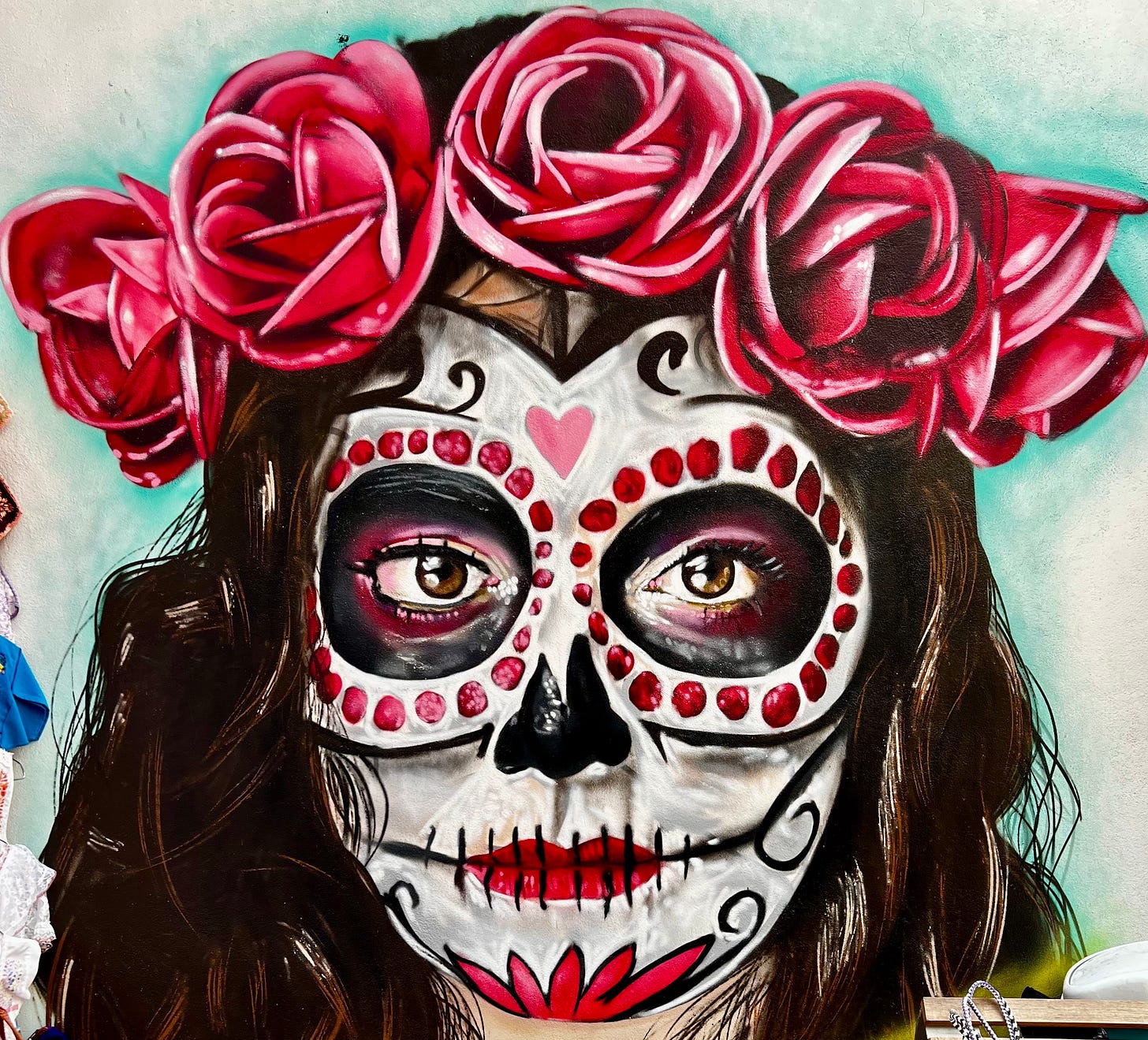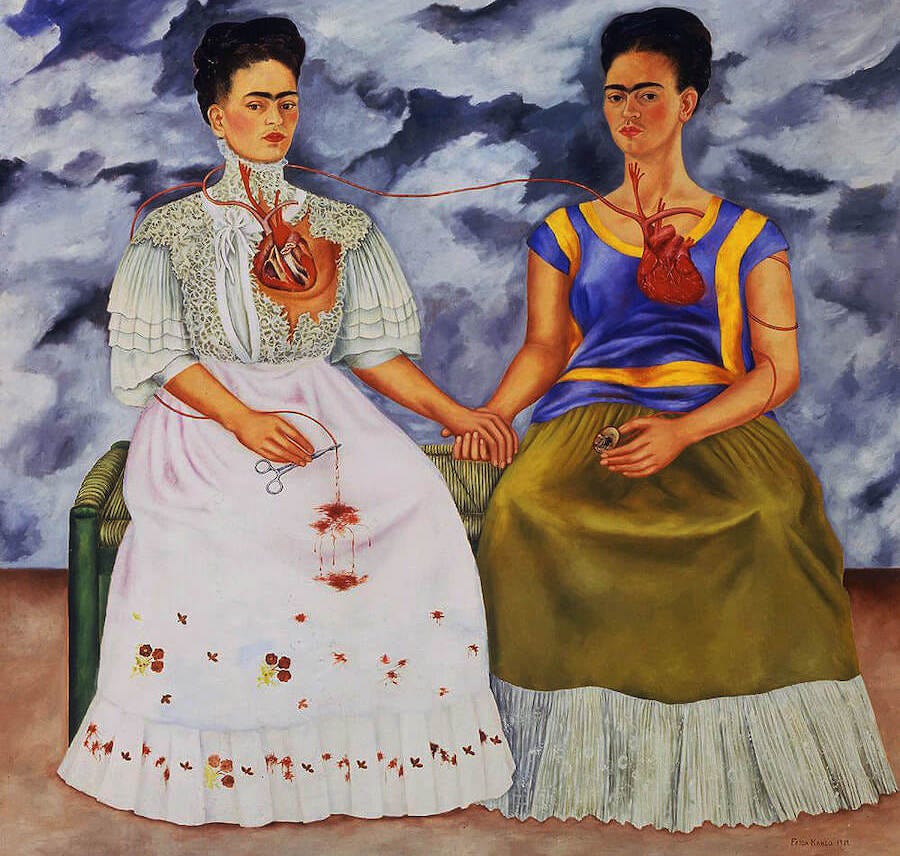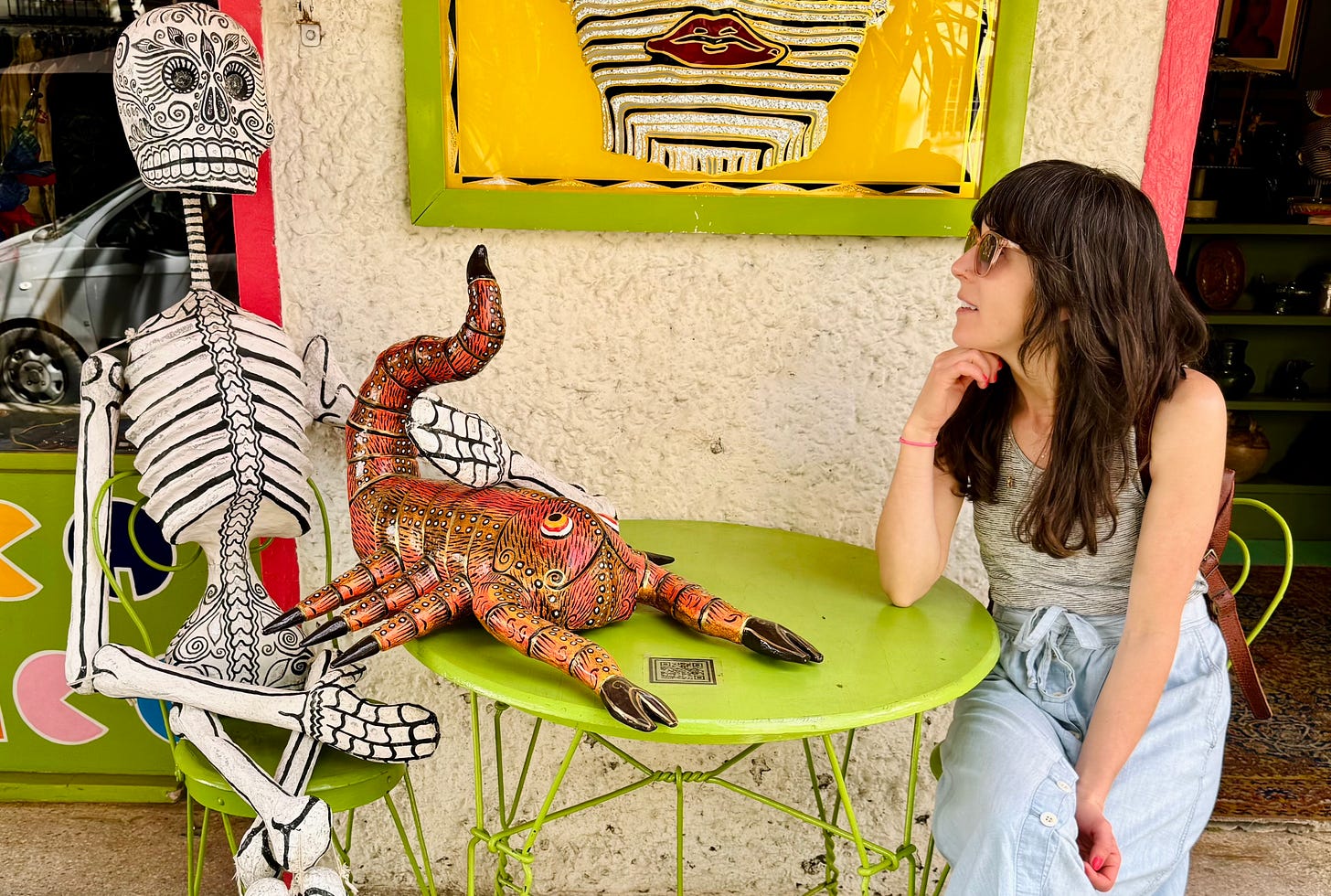By day, Mexico City was everything I expected from my much anticipated 40th birthday trip. A smorgasbord of culture, a multi-sensory feast. The braided aroma of peppery hoja santa, chemical cleaners, and sizzling pork on rotating spits. The vibrant gallery of street murals. The looped recording played over pickup truck loudspeakers, rattling off the used appliances they would buy: Se compran refrigeradores, lavadores, microondas, estufos! A vendor discreetly sold single cigarettes on one corner while a dog-walker deftly managed eight leashes on another. My husband and I ate and walked our way through the city’s delights, holding hands as we dashed across chaotic traffic and remembering, away from the nonstop logistics of parenting young children, how much we enjoyed each other.
But each night as my husband—usually the night owl—fell easily asleep beside me, I would listen enviously to his peaceful breathing, growing more anxious and discouraged with each passing hour. I read for hours without a twinge of drowsiness, until 3 a.m. on a good night. Until birds began chirping on the worst nights, when it was only a matter of time before an accelerating motorcycle or a barking dog shattered my brief, precious sleep. I was going on my fourth week of insomnia when we arrived in Mexico City, but I hadn’t gotten used to the loneliness of being involuntarily awake when seemingly the entire world is asleep. In the morning, my eyes would burn, my brain in a fog, as I powered through another day, refusing to let my lack of sleep ruin a trip meant to mark the adventure of a new decade.
I would not say I was looking forward to turning 40, but I hadn’t been dreading it. As I edged past 35 and tipped ever closer, I had congratulated myself for not participating in the cliché aversion to aging (specifically, to women aging). It’s just a number, I told myself. I was totally at peace with my age—until a month before my 40th birthday, when I’d spiraled into insomnia with a clockwork that seemed remarkably cruel. I knew changes would come with this decade, but I didn’t expect such punctuality. My sleep-deprived laments to friends were met with knowing nods, whispers of perimenopause, and more than one empathetic “Welcome to the club.” Turning 40 was a milestone I wanted to celebrate, but with each sleepless night, my dread grew. If this was the club, I wanted out.
//
The cacophony of the street was replaced by a reverent hush the moment I passed through the high blue walls of the Casa Azul. Hidden inside was a garden cathedral of cacti and fronds where Frida Kahlo once sat with her menagerie of spider monkeys and parakeets, painting her stories, transforming her pain into beauty like a patron saint of malady. Visiting her home felt like a pilgrimage, my original inspiration for coming to Mexico City.
The insomnia was not the first sign that my body is aging. I had gum surgery (twice) last year. One troublesome vertebra in my neck requires regular chiropractic maintenance. My right knee hurts if I run too far. The fine lines around my eyes stretch further, etch insistently deeper. With her childhood polio, near-fatal trolley accident, multiple miscarriages, lifelong chronic pain, and more than 30 operations, I was grateful Frida couldn’t hear my litany of ailments.
Passing quietly through the rooms of Frida’s home, her presence was still palpable. Corked jars of paint and a bundle of brushes here. Her easel, custom-made to accommodate her wheelchair, there. The plaster spine corset that she decorated with a red hammer and sickle and circles of colored glass, like portholes into her imperfect body. Her bed with the mirror installed in the canopy so she could continue painting the self-portraits that would immortalize her.
In preparation for this trip, our first time away from both kids, my husband and I did something we’d avoided: we wrote our will. One night after the kids were in bed, he matter-of-factly told me what he wanted done with his remains—“In case I die but you don’t.” I burst into tears. The insomnia, along with the fear of aging, had already begun, so I was fragile. He pressed forward tenderly, asking what I wanted. I said I didn’t know.
“Well,” he said gently, “you should think about it.”
“But I don’t want to think about it,” I said stubbornly.
I did not need another thing keeping me up at night, but he was right, of course. I should know something as significant as what I want to happen to my body when I die. It’s not about indecision, though. It’s that I feel nothing, no revulsion or inclination toward any option, because I simply cannot fathom my own death.
I am a planner. Before we left on our trip, I wrote a 1,500-word childcare manual for my parents, with detailed school drop-off and bedtime routines, dinner suggestions, snack and screen time instructions. I baked a batch of my kids’ favorite muffins and prepared a week of notes on napkins for my daughter’s lunchbox. But I could not make a plan for the eventuality of my death. Perhaps my newfound tension with 40 is not just about the insomnia but is rooted more deeply in a discomfort with my own mortality. Maybe the reason I never worried about turning 40 is because I couldn’t imagine 40, much less beyond.
In the last room you come to in Frida’s house, atop a wooden desk, rests a clay urn that holds the artist’s ashes. Just behind it is a mirror, so that you cannot look at the urn without also looking at your own reflection.
//
The night before we planned to visit the pyramids of Teotihuacán, I slept 90 minutes. Hiking around sunbaked ruins at 7,600 feet sounded miserable, so we postponed. The next morning after a whopping four hours of sleep—my best night of the trip—I felt like I could do anything.
Boarding the bus marked “piramides” and taking my seat next to my husband, I slipped through a portal to a reel of all the buses we’d taken through South America a decade earlier. That haze of nostalgia stayed with me as we explored the Aztec complex of temples and pyramids and cataloged the other ancient ruins we’ve visited together. Machu Picchu and Ephesus, Borobudur and the Acropolis. In each of these places I’ve wondered: Could any of these societies have imagined their bustling world an uninhabited ruin? And in each place, I have felt the same startling speed of time, how my own life is but a blip in the span of history, a speck of dust floating in some future wind. At times I wonder if my desire to write a book is just the human impulse to leave a piece of myself behind. My version of a pyramid or painting. Something to prove I existed.
The Pyramid of the Moon and the Pyramid of the Sun—Teotihuacán’s two largest structures—are connected by the Avenue of the Dead. As we walked the five dusty kilometers between the imposing manmade mountains, I tried to picture the people who lifted these stones into staircases leading to the heavens, who offered up human and animal sacrifices to their gods. Everywhere I looked that week, I’d been confronted with this proximity to death in Mexican culture. Papier-mâché skeletons hanging from doorways, a dancing skeleton in the ballet folklórico. Murals of bloody revolutionary battles, of women with pale faces and dark sunken eyes, lips stitched shut and hair adorned with flowers. I didn’t come to Mexico City for a reckoning with mortality, but we notice what we need to see.
//
As I familiarized myself with the sounds of Mexico City after midnight, I thought longingly of all the places and ease with which I have slept. Overnight buses in Patagonia. Hostels packed wall-to-wall with bunk beds. In a tent on a beach in Naxos, in a sleeping bag on the deck of a ferry from Greece to Italy. Maybe it was not so much the places I longed for as the person.
Painted in 1939 during her divorce from Diego Rivera, “The Two Fridas” is one of Frida Kahlo’s most iconic works. On a wooden bench in front of a tumultuous swirl of clouds, a pair of Fridas sit side by side holding hands. One is dressed in a white European gown with a high-necked bodice of lace and ruffles, the other in the colorful traditional Tehuana clothing she is known for—a purple and gold tunic with an olive-green skirt. Each has an exposed heart connected to the other by a crimson artery. The heart of the traditional Frida is intact, while the modern Frida’s heart is torn open. A blood vessel from the broken heart loops behind her arm into her lap, clamped with surgical scissors and dripping blood onto her white skirt. Twined yet at odds, the two Fridas are thought to reflect not only her heartbreak over Diego, but the struggle between the artist’s conflicting identities—the dualities contained within each of us.
Her double self-portrait was one of my favorites even before I glimpsed myself in it. My imagined self is still in her 20s, trotting the globe, sleeping like a baby. She does not always recognize the body she now inhabits and is shocked to find herself at the threshold of midlife. The first half of my life sits uncomfortably next to the second half of my life. I want them to hold hands. To make peace with one another.
//
On our last day in Mexico City, my husband and I set out to find a vintage map of the city, our souvenir of choice wherever we go. We’d searched all week, ducking into antique shops and bookstores packed with dusty leather volumes and napping cats. “Un mapa viejo?” we would inquire. We were met with similar reactions each time, a mix of surprise, confusion and secrecy. We tried changing our vocab. “Un mapa historico?” No no, we were told. Then we got a promising tip: a whole street of bookstores in the Centro Histórico.
En route, our Uber driver turned a corner and we were suddenly surrounded by elaborate, poofy quinceañera gowns. In every shop window for several blocks, they hung in lavender and magenta, turquoise and tangerine. Mannequins spun in slow mesmerizing circles. Walls glittered with tiaras. An entire shopping district devoted to another milestone. If the Mexican Quinceañera and the American Sweet Sixteen celebrate a girl’s coming of age, her entrance into womanhood, then what is 40? I want to step into 40 with the sparkling enthusiasm of those gowns, but I’m not entirely sure what it is I’m entering. A new chapter shimmering with possibility? A decade of sleeplessness and other unwelcome changes? Maybe Frida and I are doing the same thing, she with her paintbrush, me with my words, trying to make sense of who we see in the mirror, who we are in this body in this moment of our lives.
The driver took another turn and dropped us at our destination, where we tried out a revised question in half a dozen shops: “Tienes un plan de la ciudad?” More headshaking, more baffled looks. Es complicado, the last bookseller told us. As we’d rephrased our question, I kept returning to my own: Is there a map for getting older? The answer, I think, is no. It’s complicated here in the middle. We never found a map, but I discovered a place that knows how to celebrate the whole road—where we’ve been and where we’re going.
I turned 40 a week after we came home from Mexico City. As I tucked my daughter in the night of my birthday, she pulled me close and whispered, “You’re the best mommy in the whole world and I’ll never forget you, even when you die.” Heart exposed, I blinked back tears and accepted her gift, impeccably timed.
Who I’m Reading
I am very into my grad school friend’s new Substack Sea Diary. Beware, you may find yourself wanting to take up year-round ocean swimming or move to Cape Cod, or perhaps you will be content, as I am, to experience it through Hannah’s gorgeous words.
Currently reading and loving: Lilly Dancyger’s First Love, a collection of linked essay celebrating female friendship, and Erica Berry’s Wolfish, a brilliantly braided exploration of fear and our myths about wolves.
What I’m Writing
My son just turned 3, so I’ve been working on his birthday letter. I started this ritual with my daughter’s first birthday, to capture a yearly snapshot of what they love, that adorable pronunciation, their perfect particularities. I want them to be able to read these letters one day and trace the path of their becoming. I also want them to feel the tidal wave of my love in the meticulously recorded details of who they are. But the truth is these letters are more for me—the only way I’ve found to assuage the relentless rush of time, to make peace with the impossibility of pinning down every memory.
As for a book update: I am sending agent queries into the world with hope and angst! (!!)
Where I’m Going
This is a Pacific Northwest summer. While I’m always itching to use my passport, the fact is I live in one of the most glorious corners of the world to be in the summer, where the clouds turn tangerine and cotton candy pink around 8:30 p.m. and the sky is still a whisper of lilac an hour later. So, we are filling these months with the Oregon Coast, a week on magical Orcas Island, and camping on Mount Hood in my childhood VW pop-up van. Blueberry-picking and after-dinner bicycle joy rides. This summer I’m right where I want to be: in the sprinklers and popsicles of now.










“I didn’t come to Mexico City for a reckoning with mortality, but we notice what we need to see.” Love this essay.